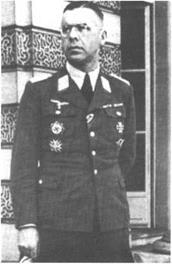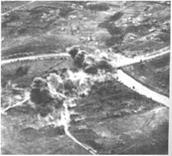Annihilation at Kiev
fter the successful encirclement battle at Uman in southwestern Ukraine, the German Army Group South hesitated to launch a head-on assault against the heavily defended Ukrainian capital of Kiev. Instead, the bulk of Army Group South concentrated on wiping out the Soviet forces to the west of the lower Dnieper River and on establishing bridgeheads across the waterway. To the south, along the Black Sea coast, the German Eleventh and Romanian Fourth armies advanced toward the Dneiper mouth, with the seizure of the important Black Sea port of Odessa as their primary goal.
On the right flank of the German Army Group South, the bomber units of Fliegerkorps V opened a series of intensive air raids on August 17 against the traffic center of Dnepropetrovsk. These were designed to delay an orderly retreat of the Red Army forces remaining to the west of the Dnieper bend; the main targets for these raids were the railroad station, thoroughfares, and bridges.
Panzergruppe 1 succeeded in establishing the first bridgehead at Zaporozhye, in the southern Dnieper bend, on August 19. Three days later, the German Seventeenth Army seized Cherkassy, about two hundred miles farther up up the Dnieper, and established a second bridgehead, on the eastern bank of the wide river.
On the left flank of Army Group South, the German Sixth Army pushed the Soviet Fifth Army, subject to unremitting attacks from the bombers of Fliegerkorps V, toward the Dnieper. On August 23 the Soviet Fifth Army had to give up its positions on the western Dneiper bank at Gornostaypol, thirty miles north of Kiev. A major Soviet setback in this sector came when the
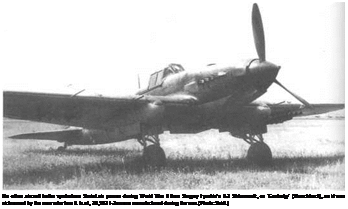 |
defenders failed to destroy the wooden road bridge across the river. By the evening of August 23, the spearheads of the German Sixth Army had established positions on the eastern side of the Dnieper.
That day, also, Generaloberst Heinz Guderian’s Panzergruppe 2 of Army Group Center delivered a heavy blow to the south from the Gomel area, 130 miles north of Kiev. This was the opening of the largest encirclement battle in history. Fliegerkorps II of Luftflotte 2, including crack units such as JG 51 and SKG 210, provided effective air support for Guderian’s drive to the south. The tank columns of Panzergruppe 2 paved their way through weak Red Army forces in the border between the Soviet Thirteenth and Fortieth armies. Any attempt to resist was met by rapid aerial attacks from SKG 210. Meanwhile, the medium bombers of KG 3 and KG 53 devastated the railway junction at Chernigov, on the Desna River 100 miles to the south. On the first day, Guderian’s armored troops advanced sixty miles. On August 24, they seized the intact Desna bridge at Novgorod-Severskiy.
Fighting desperately to relieve its ground troops from the air, the crack 126 IAP filed an extraordinary claim on this day—seventeen aerial victories. Counting aces such
as Leytenant Stepan Ridnyy and Mladshiy Leytenant ■ Vladimir Kamenshchikov in its ranks, 126 IAP had been 1 credited with thirty-six aerial victories against twenty – я seven MiG-3s and l-16s lost in combat during the first я seven weeks of the war.
Soviet reaction to the new double threat was swift. Я To the south, General-Leytenant Kirponos, the com – jfl mander of the Southwestern Front, ordered his aviation 9 assets against the Dnieper bridge at Gornostaypol. These I forces were met by strong concentrations of German fight- | ers and antiaircraft fire, which were credited with the 1 destruction of thirty-three attacking aircraft on August 1 24 alone. But finally the pilot of one of the new 11-2 1 Shturmoviks, Leytenant Sergey Kolybin of 74 ShAP, man – | aged to place two incendiary bombs on the wooden bridge. | Kolybin’s plane was hit by AAA fire and crashed into a concentration of vehicles.1 The surviving German sol – | diers helplessly witnessed the costly bridge falling prey to я the flames.2 Fliegerkorps V’s Oberst Hermann Plocher 1 established that the loss of this bridge “adversely affected | further river-crossing operations and considerably delayed I the attack by the Sixth Army.”3
As Army Group South’s Panzergruppe 1 established a a new bridgehead across the Dnieper at Dnepropetrovsk, Я
north of Zaporozhye, on August 25, the Germans were immediately confronted with heavy air attacks from the DBA and VVS-Southern Front, including 11-2 Shturmoviks entering service with 210 ShAP. During the first two days, the aircraft of 210 ShAP were reported to have put several tanks and eighteen vehicles out of commission in the Dnepropetrovsk bridgehead. The diary of the German High Command noted: “In spite of own fighter cover, there are heavy and uninterrupted low-level attacks against the bridge and bridgehead at Dnepropetrovsk. These attacks were intensified during the evening hours.”4 Thirteen airmen from 210 ShAP were decorated for these missions, which were carried out in defiance of the intercepting Bf 109s of D./JG 3.
By this time the rapid decrease in the number of serviceable aircraft became a mounting problem to the Luftwaffe. During the last days of August, Luftflotte 4 could muster no more than 320 bombers, 20 fighters, and 35 reconnaissance aircraft. At the same time, the WS of the Southwestern and Southern fronts possessed 493 bombers, 473 fighters, and 20 reconnaissance aircraft. The support by the air forces of Germany’s allies was vital in this sector.
Thus the Soviets met pilots of several different nationalities who were fighting on the German side. Apart from the Romanians in the South, there already were Hungarian and Slovakian airmen flying alongside the Luftwaffe in the Ukrainian skies. On August 27 the Italian 22 Gruppo, equipped with fifty-one MC.200 Saetta single-engine fighters, commenced operations with a low – level attack against Soviet troops near Dnepropetrovsk. When they returned to base, the Italian fighter pilots reported eight confirmed and four “probable” victories.
In the North, the impact of the strafing attacks by SKG 210 permitted Generaloberst Guderian’s troops to cross the Rozhok River almost without suffering any casualties on August 26. Meanwhile, Stalin was preparing a great surprise for Guderian. A new Soviet army group—the Bryansk Front—was formed under command of General-Leytenant Andrey Yeremenko. The intention of the Bryansk Front, equipped with the best Soviet material, including Katyusha rockets and T-34 tanks, was to annihilate Guderian’s presumptuous Panzergruppe through a threefold attack from the east, south, and west.
An air force consisting 464 combat aircraft was assigned to Yeremenko’s new front. The foundation of the new VVS-Bryansk Front, commanded by General – Mayor Fyodor Polynin, is quite telling with respect to the Soviet reinforcement capacity. In August 1941 the new’ Stavka Reserve, including strong aviation units, was built up. Within a short time, six reserve aviation groups (RAGs), equipped with the most modern aircraft, were commissioned. The first RAG was allocated to the Bryansk Front, and all 11-2 Shturmovik regiments from the Reserve Front were transferred to the VVS-Bryansk Front. Other units arrived from the Transcaucasus Military District, from the Moscow PVO, from the Naval Air Force, and by means of the absorption of the Central Front into the Bryansk Front. These forces were supplemented with aircraft brought in from flight schools.
The largely inexperienced airmen of the new VVS – Bryansk Front stood little chance against the veterans of JG 51, w’ho claimed thirty-five victories in the air over the Panzer spearheads on August 27. The bombers of Fliegerkorps II effectively frustrated Yeremenko’s preparations for the offensive, delaying the arrival of large contingents of the Bryansk Front’s combat divisions to the deployment area. But when Yeremenko finally launched his offensive on August 29, it was with such force that it compelled Guderian to halt his advance and turn to defense.
Fliegerkorps II and VVS-Bryansk Front launched everything they had along the front. On the first day of the counteroffensive, crew’s in TB-3 four-engine bombers of 42 BAD (formerly З BAK) made two sorties each; the SB, Pe-2, and 11-2 crews, three or four sorties each; and the fighter pilots, six or seven sorties each. Forty – three aircraft were claimed shot down by the Germans on the first day, but despite these losses, the Soviets carried out a total of fiften hundred sorties on August 30 and 31.
Nevertheless, the hardest strikes against ground targets were dealt by the Luftwaffe. A Red Army senior officer later recalled how’ “the continous enemy air strikes held our troops down.”3
In the South, the preparations for Army Group South’s pincer movement were completed during the last two days of August, as a number of new bridgeheads were established across the Dnieper River south of Kiev. In the Dnepropetrovsk area on. August 30, I1I./JG 77 Herzas claimed three victories against two losses in
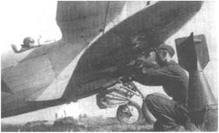
 combat with VVS units that included 88 IAP. Among the Soviet pilots shot down was six-victory ace Leytenant Vasiliy Knyazev, who was fortunate to survive. On August 31, in the same area, Il./JG 3’s Oberfeldwebel Heinrich Brenner claimed a DB-3, followed by a “V-l 1” (probably an 11-2 of 210 ShAP). That day, also, the pilots of I1./JG 3 destroyed six Soviet aircraft in the air over the Kremenchug sector, including a TB-3 heavy bomber of 14 ТВАР shot down by the unit commander, Hauptmann Gordon Gollob (his thirty-sixth victory).
combat with VVS units that included 88 IAP. Among the Soviet pilots shot down was six-victory ace Leytenant Vasiliy Knyazev, who was fortunate to survive. On August 31, in the same area, Il./JG 3’s Oberfeldwebel Heinrich Brenner claimed a DB-3, followed by a “V-l 1” (probably an 11-2 of 210 ShAP). That day, also, the pilots of I1./JG 3 destroyed six Soviet aircraft in the air over the Kremenchug sector, including a TB-3 heavy bomber of 14 ТВАР shot down by the unit commander, Hauptmann Gordon Gollob (his thirty-sixth victory).
On the first day of September, stiff dogfights cost Ш./JG 52 three pilots, including the Staffelkapitan of 7./JG 52, Oberleutnant Hans-Jorg Zimmermann, who was credited with seven victories. Meanwhile, Oberfeldwebel Brenner of II./JG 3 continued his string of successes by downing an SB. Minutes later, a Soviet fighter pilot in an 1-16 scored hits on the radiator in Brenner’s Bf 109. The German pilot disengaged and managed to bring his plane back over German lines, where he made a nice belly landing.
Early in September, the largest aerial combats in the operational area of Luftflotte 4 were fought over the Dnepropetrovsk and Kremenchug bridgeheads in the South, where the decimated forces of VVS-Southern Front made desperate attempts to destroy the bridgeheads of the German Seventeeth Army and Panzergruppe 1. With the bulk of the aircraft on the southern combat zone concentrated in the VVS-Southwestern Front, the
Southern Front could count no more than 119 serviceable aircraft on September 1. One hundred two aircraft had been registered as “total losses” during the past five weeks, including seventy-seven during combat missions.4 210 ShAP had lost eleven of its planes, with two others severely damaged, during its first weeks of combat.7 і On September 2 the Soviets lost another of their precious experienced airmen in this combat zone when 43 lAP’s Leytenant Sergey Zaytsev, credited with seven personal victories, was shot down and killed.
Luftflotte 4 concentrated all three Gruppen of JG 3 in the Kremenchug area, and on September 4 the Germans severely handled the remains of VVS-Southem| Front, claiming forty-two Soviet aircraft destroyed. The commander of the VVS-Southern Front, General-MayofJ Shelukhin, decided to dispatch some of his best airmen to neutralize the threat from JG 3. On September 7, at dusk, 249 LAP, under the command of Kapitan Aleksandr Khalutin, to which Kapitan Farit Fatkullin’s crack Staff Eskadrilya/44 IAD was attached, launched a surprise attack on the JG 3 base at Mironovka, on the right bank of the Dnieper south of Kremenchug.
249 LAP was one of the most successful Soviet fighter; units in the Southern Front during this period. Among its pilots was the famous fighter ace Kapitan Petr Kozachenko. The regiment had a mixed composition of | l-153s (deriving from the disbanded 248 LAP), l-16s, and one LaGG-3. The LaGG-3 involved a very peculiar story. While the regiment was based at Kotivets Airdrome in the vicinity of Dnepropetrovsk in August 1941, one of the pilots found a deserted LaGG-3 that had made a forced landing near the airfield. This plane was repaired and passed among the pilots in the regiment. More than twenty pilots thus managed to become familiar with the LaGG – 3 prior to the regiment’s official transition to LaGG-3 later in September. | The Mironovka raid was described both in Pravda8 and in the following words from the German point of view: “Fcldwebel [Werner] Lucas of 4 Staffel, who was airborne, spotted the incoming bombers. He sent a warning through radio. Nevertheless, the bombs were already falling as the Gruppe scrambled.”9 Feldwebel Lucas dived on the attack-
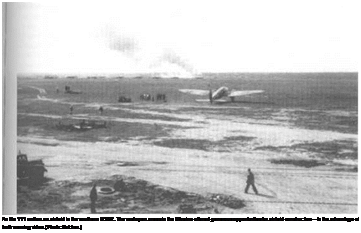 |
during the air war above the Dnieper bridges farther to the north. Commanded by Senior Lieutenant Ivan Haluznicky, 12 Letka was entrusted with the task of defending the new bridge at Gornostaypol, north of Kiev. While fending off nine I-16s attempting to attack the bridge on September 7, ten Avia B-534s claimed to have shot down two of the attackers. On September 8 three Avias of 12 Letka battled with two Ishaks over Gornostaypol and shot down one of them.[1] [2]
On the latter date, General-Leytenant Yeremenko was compelled to cancel his counteroffensive against Guderian’s Panzergruppe 2 in the North, and started to retreat. As a measure of the enormous impact the German bomber units had on the Red Army, take the success claims by KG 3 Blitz: During the first eleven weeks of Operation Barbarossa, this Kampfgeschwader was credited with the destruction of 349 trains, 488 trucks, 30 tanks and 450 Soviet aircraft on the ground, to which should be added twenty-one Soviet aircraft claimed shot down in the air. In the sky over the battlefield, littered
with scores of burning Soviet tanks, Oberst Werner Molders’s successor as Geschwaderkommodore in JG 51, Major Friedrich Beckh, achieved his Jagdgeschwader’s 2,000th aerial victory on September 8. Counted on the loss side this day was the deputy commander of II./JG 51, thirty-victory ace Oberleutnant Erich Hohagen, who was shot down in aerial combat and severely wounded.
On the lower Dnieper, 63 BAB and 32 1AP of the ChF launched a Zveno raid against the German river crossing at Berislav on September 8. The Soviet aircraft were intercepted by the Bf 109s of I1I./JG 77 and lost one I-16SPB and one of the escorting Yak-ls, the former being registered as Leutnant Emil Omcrt’s eighteenth victory. Another clash between the same units over this target area on the following day ended in the Soviets’ favor, with 32 1 АР/ChF claiming two Bf 109s shot down lor no losses. In fact, 7./JG 77 recorded two Bf 109s force-landed with battle damage.
The Kiev drama unfolded rapidly. On September 10, Army Group South’s Seventeenth Army and Panzergruppe 1 started moving out of the Dnieper bridgehead at Krcmenchug to advance toward the north. They were heavily supported by the units of Fliegerkorps V. Soviet strongholds and troop movements were subjected to intense aerial attacks. In the North, Romny, 120 miles to the east of Kiev, was captured by Guderian’s troops on September 10.
At this point Stalin decided to intervene personally by directing 90 percent of VVS-Southwestern Front against the enemy’s armored spearheads in the Romny sector. The missions carried out in this area on September 12 claimed one of the first Soviet female-pilot casualties of the war, Starshiy Leytenant Yekaterina Zelyenko, one of the first women to enter service in the VVS as a combat pilot. Having had her baptism of fire in the Winter War against Finland, Zelyenko was appointed deputy commander of an Su-2 Eskadrilya of 135 BAP in 1941.
Returning from a combat sortie in the Romny sector, Starshiy Leytenant Zclycnkos bomber was attacked by seven Bf 109s from JG 51. During the initial fighter attack, otic Bf 109 was claimed shot down by Zelyenko’s gunner, but the other Messerchmitts continued to attack the bomber, and a full burst killed the gunner. As Zelyenko’s machine guns had run out of ammunition and the bomber was set on fire, she directed her Su-2 right into the closest Bf 109. Shrapnel from the smashed
Bf 109 hit and killed Zelyenko instantly. Only on May 5, 1990, did Mikhail Gorbachev decide to award Yekaterina Zelyenko the title of Hero of the Soviet Union posthumously.
To the south, Marshal Budyonny ordered the. Soviet Thirty-eighth Army to launch a counterattack against Panzergruppe 1 at Kremenchug. The Thirty-eighth Army was immediately beset by “rolling attacks” from the air. On September 12 the army headquarters reported: “Impossible to move in open terrain due to aerial attacks.”1’ The entire counterattack was canceled that day.
The Soviets next resorted to hit-and-run fighter – bomber sorties against the river crossings. On September 13, more than a dozen major fighter-bomber raids were carried out in this sector. The sky over the Dneiper bridges at Kremenchug was filled with Soviet fighter-bombers attempting to evade the aggressive attacks of the Bf 109s. On September 13 alone, II./JG 3 was reported to have shot down twenty Soviet airplanes, including thirteen “V-l Is”—probably 11-2s—for the loss of only one Bf 109.
As the ring was closing around the Southwestern Front in the Kiev area, the Soviet commanders appealed to the Stavka for permission to withdraw. But Stalin had decided to defend Kiev at all costs. He dismissed Marshal Budyonny as supreme commander of the Southwestern Zone and replaced him with Marshal Timoshenko. Stalin also sent the following harsh wire to the Kiev defenders: “Once and for all, you have to stop looking for possibilities to retreat. Instead, you must concentrate on the possibilities of resisting and only resisting.”
Early on September 14, Soviet aircraft raided the base of JG 3 at Mironovka once again. Two Bf 109s managed to take off. The pilots, Hauptmann Gollob and his wingman, Oberleutnant Walthcr Dahl, pursued the attackers back over the Dnieper and later returned with claims of two I-153s shot down. Both Gollob and Dahl were known to be very ambitious, and at least the latter has been proven to have wildly exaggerated some of he successes.
Also on September 14, Leytenant Arseniy Stepanov, f rom Kapitan Farit Fatkullin’s Staff Eskadrilya/44IAD, was out on a patrol mission in the same area when he discovered an enemy airfield on which two Ju 87s were j being refueled. Stepanov put the nose of his 1-І 53 Chayka down and strafed the field, sett ing both Ju 87s on fire | Heading for home after the attack, Stepanov found him – j
self pursued by two Bf 109s. A stiff twenty-minute dogfight ensued until Arseniy Stepanov managed to hit one of the Bf 109s and then get away.13 Shortly afterward, the 1-153 flight led by Starshiy Politruk Boris Vasilyev, from the same unit, made another attack against the same airfield. This time seven enemy aircraft were claimed destroyed on the ground. During the return flight, Leytenant Grigoriy Kotseba became separated from his comrades and got involved in a prolonged dogfight with four Bf 109s, from which he was lucky to escape alive.
Meanwhile, the bombers and dive-bombers of Fliegerkorps 11 and V were engaged in preventing any “volunteer attempts” by the Soviet Southwestern Front to escape to the east. Day and night, hundreds of He Ills and Ju 88s hammered the lines of communication in the rear area, repeating the successful “envelopment from the air” that had preceded the battle of annihilation at Uman in July and August. By September 14, Fliegerkorps V had destroyed or damaged 727 trucks in this sector. During the “envelopment from the air” against Kiev, Hauptmann Rudolf Kiel’s I./KG 55 Greif was credited with the destruction of 58 railway cars, 675 trucks, and 22 tanks. One He 111 crew, led by Oberleutnant Adalbert Karbe, the Staffelkapitan in 3./ KG 55, distinguished itself by destroying seven railway trains during a single mission. The Ju 88 crews of I./KG 54Totenkopf also achieved considerable success during these operations, and on September 19 the commander of this Gruppe, Major Richard Linke, was awarded the Knight’s Cross. By that time his 1./KG 54 had been credited with the destruction of 240 Soviet aircraft on the ground, hundreds of tanks and artillery pieces, and thousands of vehicles. Moreover, the Gruppenkommandeur had knocked out thirty Soviet tanks himself.1,1
Oberst Hermann Plocher, the Fliegerkorps V chief of staff wrote: “The German isolation of the Kiev pocket was exemplary, with the bombers of the Fliegerkorps V ; (Luftflotte 4) operating from the Kirovograd area in the south and those of the Fliegerkorps II (Luftflotte 2) from north of Gomel and Orsha in the north.”15
j On September 16, Panzergruppen 1 and 2 met at і Lokhvitsa, 130 miles east of Kiev, thus closing the ring around five Soviet armies. The full meaning of Stalin’s I order that Kiev must be held “at any cost” was nothing j less than total annihilation, in the air as well as on the ground.
|
|
Oberst Hermann Plocher served as chief of staff of Fliegerkorps V from 1940 to 1943. He had received pilot training at Lipetsk in the USSR in 1928 and served with the Condor Legion in Spain. After the war, he wrote an important book about the German Air Force versus the Soviet Union. (Photo: Bundesarchiv.)
On September 18 the German Sixth Army opened its offensive against Kiev from the west By now the intense air activity in combination with strung-out supply lines and inadequate transport space created a severe fuel shortage on the Luftwaffe airfields in the Ukraine. Most twin-engine bombers of Fliegerkorps V w-ere grounded during the days following the closing of the ring around Kiev. Thus increased demands were put on the single-engine Ju 87 dive-bombers of lII./StG 77. Flying four to six sorties each day, the Stuka airmen of this unit fell upon the bunkers and artillery positions in the approaches to the Kiev citadel, breaking all resistance. On September 19 the fortress was in German hands. On September 20, the commander of the Southwestern Front,
General-Polkovnik Mikhail Kirponos, was killed in combat.
Stalin had already practically given up Kiev and the hundreds of thousands of entrapped Soviet soldiers. The skies over Kiev were completely handed over to the Luftwaffe. The remains of the WS-Southwestern Front were concentrated in the Poltava sector, against the east – bound advance of the German Seventeenth Army, now two hundred miles from Kiev. Here, the Soviet airmen fought vehemently to halt the German offensive and relieve their ground forces. On September 20 I1I./JG 52 lost four Bf 109s in this sector.
Even if the fuel shortage would not permit Fliegerkorps V to carry out more than an average of 140 sorties per day during the final-stage of the Battle of Kiev, this was fully sufficient to deal crippling blows against the tight concentrations of Soviet troops and equipment inside the narrow Kiev pocket. Between September 12 and September 21, Fliegerkorps V claimed 42 aircraft, 23 tanks, and 2,171 motor vehicles destroyed on the ground, plus 65 Soviet planes shot down in the air.
The Soviet Twenty-sixth Army made a desperate attempt to break out to the east on September 21. The Bf 110 high-speed bombers of SKG 210 were brought into action against this maneuver, with devastating results. General-Leytenant Fyodor Kostenko, the commander of the Twenty-sixth Army, radioed an urgent appeal to the Stavka: “All efforts to cross the river are futile. No ammunition left. Help required from the air force!"
On September 26, the greatest battle of annihilation in history was over. The Soviet Fifth, Twenty-first, Twenty-sixth, and Twenty-seventh armies had ceased to exist. According to German reports, 440,000 prisoners were taken in the Kiev pocket. Altogether, 665,000 Soviet soldiers ended up in German confinement on the battlefields in the southern combat zone between August 31 and September 26."’ The VVS recorded more than 1,500 of its aircraft lost over the Ukraine between June 22 and September 26—to no avail in preventing the disaster at Kiev.
|
A Luftwaffe bombing attack against retreating elements of the Red Army, as seen from the a German airplane. (Photo: Bundesarchiv.) |
The commander of the VVS-Southern Front, General-Mayor P. S. Shclukhin, was made the scapegoat for the failure in the air, and was replaced on September 24 by Polkovnik Konstantin Vershinin, a veteran of the Russian Civil War. The commander of the VVS – Southwestern Front, General-Leytenant Fyodor Astakhov, was trapped in the encirclement but managed to evade capture. He reached Soviet lines in November 1941, having made it three hundred miles through enemy-held territory.
The Kiev battle was an immense operational victory for the Germans, but nothing else. After the war, the German General Kurt von Tippelskirch declared: “The Russians had indeed lost a battle, but [they] won the campaign.” This would prove true as the final offensive! against Moscow was launched, too much delayed because | of the diversion of Gudcrian’s Panzergruppe to the south. I As this offensive finally opened, the Wehrmacht on the | Eastern Front had been reduced to between one-half and j one-third of its original strength.











